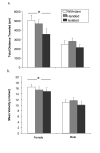Long-term behavioral consequences of brief, repeated neonatal isolation
- PMID: 17125746
- PMCID: PMC1805632
- DOI: 10.1016/j.brainres.2006.10.054
Long-term behavioral consequences of brief, repeated neonatal isolation
Abstract
Rats subjected to stressful stimuli during the stress hyporesponsive period exhibit varied neuroendocrine and behavioral changes as neonates, adolescents and adults. The current work examined the effects of neonatal isolation stress, using a within-litter design, on adult anxiety-related behavior and endocrine stress reactivity. Neonatal rats were isolated daily for 1 h from postnatal day (P) 4 to 9, a manipulation previously shown to induce hypothalamic-pituitary-adrenal (HPA) responses on P9 (Knuth, E.D., Etgen, A.M. (2005) Corticosterone secretion induced by chronic isolation in neonatal rats is sexually dimorphic and accompanied by elevated ACTH. Horm Behav 47:65-75.). Control animals were either handled briefly or left undisturbed (with-dam). Adult rats were tested for anxiety-related behavior using the elevated plus maze and open field, and for endocrine responses following restraint stress. Neonatal isolation decreased center exploration of the open field following 1 h restraint, including decreased time in the center compared to with-dam or handled controls and decreased center entries and distance traveled in the center compared to with-dam controls. It also decreased time in and entries into the open arms of the elevated plus maze compared to handled controls, suggesting enhanced anxiety-related behavior. Neonatal isolation had no effect on basal or restraint-induced levels of ACTH or corticosterone. These findings indicate that neonatal isolation may enhance anxiety-related behaviors, especially in response to stress, without altering HPA function.
Figures





References
-
- Anisman H, Zaharia MD, Meaney MJ, Merali Z. Do early-life events permanently alter behavioral and hormonal responses to stressors? Int J Dev Neurosci. 1998;16:149–164. - PubMed
-
- Bronzino JD, Kehoe P, Austin-LaFrance RJ, Rushmore RJ, Kurdian J. Neonatal isolation alters LTP in freely moving juvenile rats: sex differences. Brain Res Bull. 1996;41:175–183. - PubMed
-
- Estanislau C, Morato S. Prenatal stress produces more behavioral alterations than maternal separation in the elevated plus-maze and in the elevated T-maze. Behav Brain Res. 2005;163:70–77. - PubMed
-
- Francis D, Diorio J, LaPlante P, Weaver S, Seckl JR, Meaney MJ. The role of early environmental events in regulating neuroendocrine development. Moms, pups, stress, and glucocorticoid receptors. Ann N Y Acad Sci. 1996;794:136–152. - PubMed
Publication types
MeSH terms
Substances
Grants and funding
LinkOut - more resources
Full Text Sources
Medical

